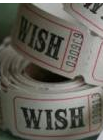Inside the Teenage Mind
Monday, May 2nd, 2011To do cognitive design we must first fathom how customers think and feel. Recent cognitive science has given us many insights into the how the mind works in terms of structures and processes but often has little or nothing to say about the actual content or what is on people’s minds. So I am also on the look out for empirical studies that pick out beliefs, desires, fears, hopes, moods or other mental states that make up the particulars of how a group of people think and feel.
 For example, take the recent study reported on EurekAlert! about the effectiveness of the three-wishes question used in the AMA’s guideline for adolescent preventative services. The idea is that a physician examining 11-18 year old patients asks “If you could have three wishes, what would they be?”. A study looking at the responses from 110 patients found:
For example, take the recent study reported on EurekAlert! about the effectiveness of the three-wishes question used in the AMA’s guideline for adolescent preventative services. The idea is that a physician examining 11-18 year old patients asks “If you could have three wishes, what would they be?”. A study looking at the responses from 110 patients found:
* 41% wished for wealth and 31% wished for a material item
* Girls tended to wish for happiness while boys wished for success
* Only 8% made wishes about personal appearance (a surprise)
Furthermore:
“Results showed that 85 percent of adolescents had wishes for themselves, 32 percent had wishes for others, and 10 percent had a wish for both themselves and others. Boys were more likely than girls to wish for things only for themselves (73 percent vs. 46 percent), while girls were more likely than boys to wish for something for their families (26 percent vs. 9 percent).”
As simple as it is, probing wishful thinking reveals psychological needs and cognitive differences at several levels.